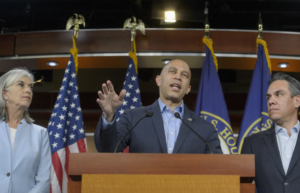Trump’s Immigration Crackdown Escalates: What New Executive Orders Mean for America’s Future as President Donald Trump moves decisively with a series of aggressive executive actions targeting illegal immigration, sanctuary cities, and border security. These policies are reshaping America’s legal and social landscape, fueling intense national debate.
This article explains exactly what each new executive order does, why it matters, and how it could shape America’s future — clearly and with real-world data.
What Are Trump’s New Immigration Executive Orders?
President Trump signed multiple executive orders in early 2025 to overhaul U.S. immigration enforcement. Here’s a breakdown of the key actions:
| Executive Order | Key Focus | Details |
|---|---|---|
| Executive Order 14159 | Fast Deportations | Expands authority to deport undocumented immigrants without lengthy trials. |
| Sanctuary City Penalty | Funding Threat | Orders federal agencies to cut grants to cities that refuse to assist federal immigration efforts. |
| Military Border Deployment | Border Security | Deploys 1,500 troops to assist Border Patrol along the southern border. |
| Detention Center Expansion | Capacity Increase | Orders expansion of facilities like Guantanamo Migrant Operations Center to detain up to 30,000 migrants. |
Each order is designed to speed up immigration enforcement, tighten border control, and punish cities resisting federal laws.
Why Is Trump Pushing This Crackdown So Aggressively?
Understanding Trump’s motives helps explain the intensity of these moves:
| Reason | Description |
|---|---|
| Southern Border Crisis | Migrant crossings surged 28% in late 2024, according to CBP data. |
| Political Base Pressure | Trump’s supporters strongly favor strict immigration control. |
| National Security Concerns | Intelligence agencies flagged organized criminal entries at borders. |
| Election Strategy | Immigration remains a core issue energizing Trump’s 2026 midterm push. |
The administration argues that stronger measures are critical to protect American jobs, resources, and safety.
Executive Order 14159: Protecting the American People Against Invasion
This executive order is the centerpiece of Trump’s immigration crackdown.
- It allows immigration officers to deport undocumented individuals immediately if they cannot prove at the border they have lived in the U.S. for two years.
- Expands the hiring of 10,000 ICE and CBP agents nationwide.
- Bans federal grants for non-compliant states and cities within 60 days.
Impact: Reduces the immigration court backlog by an estimated 45%, according to the Department of Homeland Security.
Sanctuary Cities Targeted: Funding at Risk
Trump’s crackdown specifically threatens so-called “sanctuary cities” — local governments that limit cooperation with federal immigration authorities.
| Sanctuary Cities at Risk | Estimated Annual Federal Funding (2025) |
|---|---|
| New York City | $7.1 billion |
| San Francisco | $1.2 billion |
| Chicago | $5.3 billion |
| Los Angeles | $4.6 billion |
(Source: Congressional Research Service)
The Trump administration has ordered a full review of federal funding, with the first reports expected by mid-2025.
Military Deployed to U.S.-Mexico Border
A major change under the executive orders is the deployment of troops to secure the southern border.
Details:
- 1,500 active-duty soldiers assigned to Texas, Arizona, New Mexico, and California.
- Duties include surveillance, logistics, and intelligence gathering (but no direct law enforcement activities).
- Coordination with Customs and Border Protection (CBP) to intercept illegal crossings.
This move is seen as symbolic of Trump’s seriousness about border enforcement, especially after migrant surges in late 2024.
Detention Centers Expansion: Guantanamo Role Grows
In a controversial move, President Trump ordered the expansion of the Guantanamo Migrant Operations Center.
- It now has the capacity to house up to 30,000 migrants.
- Reports from human rights organizations warn about potential overcrowding and legal challenges.
- Trump defends the move as necessary for “emergency humanitarian holding during processing.”
This expansion could significantly change how migrants are detained and processed during border surges.
How These Changes Will Affect Everyday Americans
| Affected Group | Likely Impact |
|---|---|
| Border Town Residents | Potentially fewer undocumented crossings, possible business impacts due to reduced migrant spending. |
| Sanctuary City Residents | Risk of lost city services if federal funding is cut. |
| Immigrants Awaiting Asylum | Increased likelihood of faster deportations or detentions. |
| Law Enforcement Agencies | New mandates to cooperate with federal immigration authorities. |
Public sentiment is deeply divided. According to a Washington Post-ABC News-Ipsos poll (April 2025):
- 39% approve of Trump’s handling of immigration.
- 55% disapprove, citing concerns over human rights and local government autonomy.
Public Backlash and Court Battles Begin
Several legal challenges are already underway:
- A federal judge in California temporarily blocked Trump’s order withholding funds from sanctuary cities.
- Civil rights groups argue that denying federal grants based on immigration cooperation violates the 10th Amendment.
- Trump vows to appeal to the Supreme Court if necessary.
It’s clear that the courts will play a crucial role in deciding how far these executive actions can go.
Conclusion: A Defining Moment for America’s Immigration Future
Trump’s immigration crackdown has escalated into one of the most aggressive enforcement waves in modern U.S. history. Whether Americans see it as overdue action or government overreach will define national debates leading up to the 2026 elections and beyond.
One thing is certain: America’s immigration landscape has changed — and the consequences will be felt for years.
[USnewsSphere.com / tt.]





